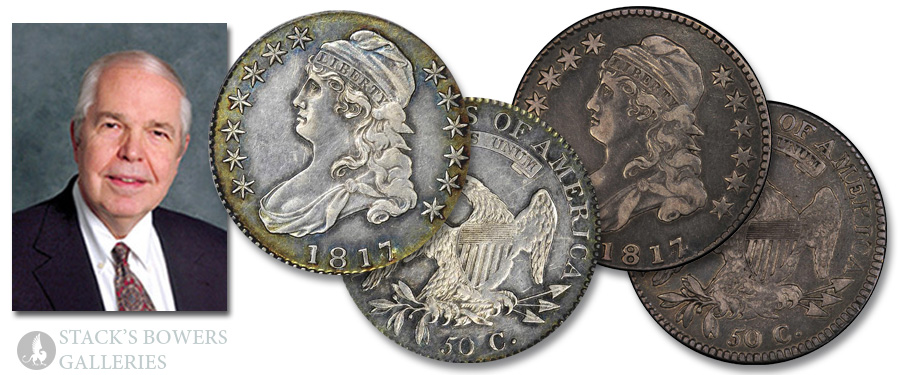
Classic rarities among American silver coins have commanded attention for a long time. The 1804 silver dollar, 1802 half dime (see No. 12), 1894-S dime, 1827 quarter, and others are highlights of any collection or auction in which they appear.
One of the most popular American specialties is Capped Bust half dollars with lettered edge. Designed by John Reich, these were minted continuously from 1807 until 1836, except for 1816 (a unique year in American coinage as only one denomination, the copper cent, was struck). Today members of the John Reich Collectors Society and others collect these by dates and major varieties as listed in A Guide Book of United States Coins, or by die varieties as described in Al C. Overton’s Early Half Dollar Die Varieties, 1794-1836. The most famous variety, and by far, is the 1817/4 overdate.
However, it was not until 1930 that anyone had heard of it!
In the October 1930 issue of The Numismatist, page 689, under "Editorial Comment-Numismatic News," was a summary of a letter received from a California correspondent:
E.T. Wallis, of Los Angeles, Cal., writes that he has recently discovered a heretofore unknown variety of the 1817 half dollar, the last figure of the date being cut over a 4. A number of half dollars of 1817 over ’13 are known, but this is the first one over ’14 reported, Mr. Wallis says.
He also says the coin is practically Uncirculated and the overdate can be seen plainly. The reverse is also an unlisted variety, as both I’s in UNITED and AMERICA have the lower right ceriphs [sic] broken off diagonally toward the right, and the I in UNITED also has the left side of the top ceriph broken off. The obverse shows a die break across the coin, starting from the border to the right of the figure 7 and through the ear and between B and E of LIBERTY to the top of the border. Mr. Wallis thinks the die may have been cracked when the 7 was cut over the 4 and the die may have broken when the striking began.
Howard R. Newcomb, of Los Angeles, and M.L. Beistle, of Shippensburg, Pa., both authorities on the half-dollar series, have examined the coin and pronounced it a hitherto unknown variety.
Martin Luther Beistle was the leading half dollar student of his day. His name appeared on the cover of A Register of Half Dollar Die Varieties and Sub-Varieties, published in 1929. Howard R. Newcomb was generally acknowledged as America’s leading scholar in the field of technical die varieties, especially with relation to his knowledge extending across many different series (most other die variety specialists were myopic, and may have been well versed in, say, 1793 large cents, but would not know a thing about an 1817 half dollar).
Edward T. Wallis, owner of the California Stamp Company, 805 West 7th Street, Los Angeles, advertised it for sale in the 1934 first edition (copyright 1933) of The National Catalog of U.S. Coins, p. 164:
For Sale
THE ONLY KNOWN
1817 Over ’14
U.S. Half Dollar
Condition is EXTREMELY FINE
A remarkable coin which was not known to exist before 1930, when we discovered it in a collection that had been in the possession of one family since 1846.
It has a decided break at the right of the figure 7 in the date, and extending up through the bust of Liberty clear across the coin.
The 4 is plainly visible under the 7.
Remember that this is a Major Variety, and no collection of United States Half Dollars is complete without it.
Price $2,500.00?
Wallis died in 1951. Al Overton purchased the discovery coin the next year, though he identified the source of the coin as the "Pratt Collection" and apparently never knew Wallis. Overton sold the discovery coin to Louis Eliasberg in 1953. In April 1997 Bowers and Merena Galleries presented the coin in their sale of the Louis E. Eliasberg, Sr. Collection.
In time, additional 1817/4 half dollars were discovered, so that by the time Stack’s Bowers Galleries offered the D. Brent Pogue Collection coin in September 2015, cataloger John Kraljevich listed 11 examples, split between two varieties: Overton-102 and Overton-102a. It is worth mentioning that the 1817/4 half dollar included in the Pogue Collection – a cabinet known for the superior quality of its pieces – was graded "just" VF-35 and yet is by far the finest known of the Overton 102 variety. When the Overton 102a variety coins are included, this VF-35 is still the third highest graded, behind only the Discovery-Eliasberg specimen at AU-53 (PCGS) and the George Williams coin, graded XF Details, Environmental Damage by NGC.





